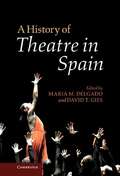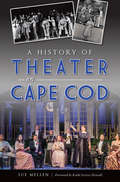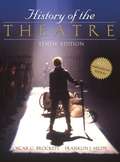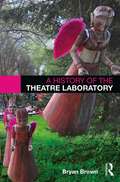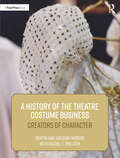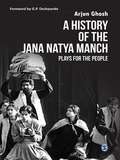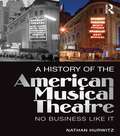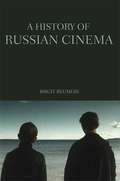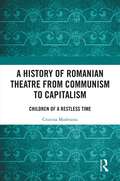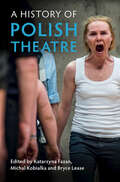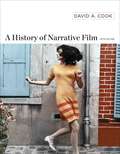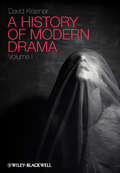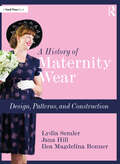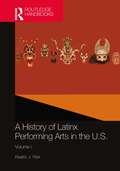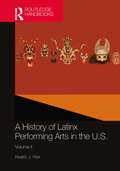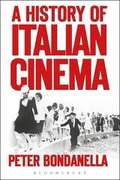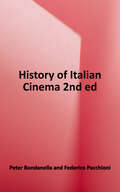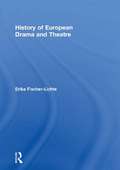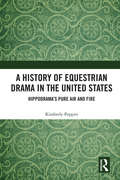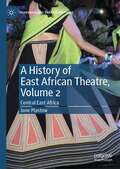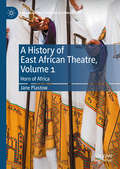- Table View
- List View
A History of Theatre in Spain
by Maria M. Delgado David T. GiesLeading theater historians and practitioners map a theatrical history that moves from the religious tropes of Medieval Iberia to the postmodern practices of twenty-first-century Spain. Considering work across the different languages of Spain, from vernacular Latin to Catalan, Galician and Basque, this history engages with the work of actors and directors, designers and publishers, agents and impresarios, and architects and ensembles, in indicating the ways in which theater has both commented on and intervened in the major debates and issues of the day. Chapters consider paratheatrical activities and popular performance, such as the comedia de magia and flamenco, alongside the works of Spain's major dramatists, from Lope de Vega to Federico García Lorca. Featuring revealing interviews with actress Nuria Espert, director Lluís Pasqual and playwright Juan Mayorga, it positions Spanish theater within a paradigm that recognizes its links and intersections with wider European and Latin American practices.
A History of Theater on Cape Cod
by Sue MellenTheater on the Cape began in 1916 when a group of artists and writers in Provincetown mounted a production of a one-act play, Bound East for Cardiff, by a little-known playwright, Eugene O'Neill. They staged the play in a rickety old theater on a wharf in what was then little more than a sleepy fishing village. From that artists' colony--and others like it across the Cape and Islands--it grew into the constantly expanding theater universe it is today. The theatrical descendants of O'Neill and the Provincetown Players continue to present classical drama, contemporary hits and new, experimental works to audiences that have come to expect the best. In her tour of the theaters from Provincetown to Falmouth, author and entertainment columnist Sue Mellen reveals the rich past behind a unique cultural treasure.
History Of the Theatre (Tenth Edition)
by Oscar G. Brockett Franklin J. HildyKnown as the "bible" of theatre history, Brockett and Hildy's History of the Theatre is the most comprehensive and widely used survey of theatre history in the market. This 40th Anniversary Edition retains all of the traditional features that have made History of the Theatre the most successful text of its kind, including worldwide coverage, more than 530 photos and illustrations, useful maps, and the expertise of Oscar G. Brockett and Franklin J. Hildy, two of the most widely respected theatre historians in the field. As with every edition, the text reflects the current state of knowledge and brings the history of theatre up to the present. This tenth edition continues to provide the most thorough and accurate assessment of theatre history available.
A History of the Theatre Laboratory
by Bryan BrownThe term ‘theatre laboratory’ has entered the regular lexicon of theatre artists, producers, scholars and critics alike, yet use of the term is far from unified, often operating as an catch-all for a web of intertwining practices, territories, pedagogies and ideologies. Russian theatre, however, has seen a clear emergence of laboratory practice that can be divided into two distinct organisational structures: the studio and the masterskaya (artisanal guild). By assessing these structures, Bryan Brown offers two archetypes of group organisation that can be applied across the arts and sciences, and reveals a complex history of the laboratory’s characteristics and functions that support the term’s use in theatre. This book’s discursive, historical approach has been informed substantially by contemporary practice, through interviews with and examinations of practitioners including Slava Polunin, Anatoli Vassiliev, Sergei Zhenovach and Dmitry Krymov.
A History of the Theatre Costume Business: Creators of Character
by Triffin I. Morris Gregory DL MorrisA History of the Theatre Costume Business is the first-ever comprehensive book on the subject, as related by award-winning actors and designers, and first hand by the drapers, tailors, and craftspeople who make the clothes that dazzle on stage. Readers will learn why stage clothes are made today, by whom, and how. They will also learn how today’s shops and ateliers arose from the shops and makers who founded the business. This never-before-told story shows that there is as much drama behind the scenes as there is in the performance: famous actors relate their intimate experiences in the fitting room, the glories of gorgeous costumes, and the mortification when things go wrong, while the costume makers explain how famous shows were created with toil, tears, and sweat, and sometimes even a little blood. This is history told by the people who were present at the creation – some of whom are no longer around to tell their own story. Based on original research and first-hand reporting, A History of the Theatre Costume Business is written for theatre professionals: actors, directors, producers, costume makers, and designers. It is also an excellent resource for all theatregoers who have marveled at the gorgeous dresses and fanciful costumes that create the magic on stage, as well as for the next generation of drapers and designers.
A History of the Theatre Costume Business: Creators of Character
by Triffin I. Morris Gregory DL Morris Rachel E. PollockA History of the Theatre Costume Business is the first-ever comprehensive book on the subject, as related by award-winning actors and designers, and first hand by the drapers, tailors, and craftspeople who make the clothes that dazzle on stage.Readers will learn why stage clothes are made today, by whom, and how. They will also learn how today’s shops and ateliers arose from the shops and makers who founded the business. This never-before-told story shows that there is as much drama behind the scenes as there is in the performance: famous actors relate their intimate experiences in the fitting room, the glories of gorgeous costumes, and the mortification when things go wrong, while the costume makers explain how famous shows were created with toil, tears, and sweat, and sometimes even a little blood. This is history told by the people who were present at the creation – some of whom are no longer around to tell their own story. Based on original research and first-hand reporting, A History of the Theatre Costume Business is written for theatre professionals: actors, directors, producers, costume makers, and designers. It is also an excellent resource for all theatregoers who have marveled at the gorgeous dresses and fanciful costumes that create the magic on stage, as well as for the next generation of drapers and designers.
A History of the Jana Natya Manch
by Arjun GhoshA History of the Jana Natya Manch chronicles the birth and growth of the Jana Natya Manch (Janam), a Delhi-based radical theater group which has been active since 1973. Beginning in the early 1970s, when a group of young students in Delhi sought to continue the legacy of the Indian Peoples' Theatre Association, the book takes a close but critical look at the various phases in the four decades of the theatre collective. The author has also captured within these pages the functioning of Janam as an organization, its methods of attracting and training fresh talent, the process of scripting, interactions with mass organizations, the experience of performing almost skin-to-skin with its spectators in the grime of Indian streets, and much more. This book is not only a narration of Janam's history, development and functioning, it is also an attempt to throw fresh light on the practice of theater.
A History of the American Musical Theatre: No Business Like It
by Nathan HurwitzFrom the diverse proto-theatres of the mid-1800s, though the revues of the ‘20s, the ‘true musicals’ of the ‘40s, the politicisation of the ‘60s and the ‘mega-musicals’ of the ‘80s, every era in American musical theatre reflected a unique set of socio-cultural factors. Nathan Hurwitz uses these factors to explain the output of each decade in turn, showing how the most popular productions spoke directly to the audiences of the time. He explores the function of musical theatre as commerce, tying each big success to the social and economic realities in which it flourished. This study spans from the earliest spectacles and minstrel shows to contemporary musicals such as Avenue Q and Spiderman. It traces the trends of this most commercial of art forms from the perspective of its audiences, explaining how staying in touch with writers and producers strove to stay in touch with these changing moods. Each chapter deals with a specific decade, introducing the main players, the key productions and the major developmentsin musical theatre during that period.
A History Of Russian Cinema
by Birgit BeumersFilm emerged in pre-Revolutionary Russia to become the 'most important of all arts' for the new Bolshevik regime and its propaganda machine. The 1920s saw a flowering of film experimentation, notably with the work of Eisenstein, and a huge growth in the audience for film, which continued into the 1930s with the rise of musicals. The films of the Second World War and Cold War periods reflected a return to political concerns in their representation of the 'enemy'. The 1960s and 1970s saw the rise of art-house films. With glasnost came the collapse of the state-run film industry and an explosion in the cinematic treatment of previously taboo topics. In the new Russia, cinema has become genuinely independent, as a commercial as well as an artistic medium. <p><p> A History of Russian Cinema is the first complete history from the beginning of film to the present day and presents an engaging narrative of both the industry and its key films in the context of Russia's social and political history.
A History of Romanian Theatre from Communism to Capitalism: Children of a Restless Time
by Cristina ModreanuA History of Romanian Theatre from Communism to Capitalism analyses the last three decades of Romanian theatre and connects it to the international stage. Cristina Modreanu questions the relationship between artists and power, both before 1989, behind the Iron Curtain, and in the current global political context, with nationalism manifesting itself in Eastern Europe, as seen in the critical work of Romanian theatre makers. This study covers the complex cases of theatre makers such as Lucian Pintilie, Liviu Ciulei and Andrei Șerban, who built their international careers in exile, and the most innovative Romanian artists of today, such as Silviu Purcărete, Mihai Măniuţiu, Gianina Cărbunariu, Radu Afrim, and Bogdan Georgescu, who reached the status of transglobal artists. Filling a considerable gap in Romanian theatre discourse, this book will be of a great interest to students and scholars of contemporary theatre and history.
A History of Polish Theatre
by Katarzyna Fazan Michal Kobialka Bryce LeasePoland is celebrated internationally for its rich and varied performance traditions and theatre histories. This groundbreaking volume is the first in English to engage with these topics across an ambitious scope, incorporating Staropolska, the Polish-Lithuanian Commonwealth, the Enlightenment and Romanticism within its broad ambit. The book also discusses theatre cultures under socialism, the emergence of canonical practitioners and training methods, the development of dramaturgical forms and stage aesthetics and the political transformations attending the ends of the First and Second World Wars. Subjects of far-reaching transnational attention such as Jerzy Grotowski and Tadeusz Kantor are contextualised alongside theatre makers and practices that have gone largely unrecognized by international readers, while the participation of ethnic minorities in the production of national culture is given fresh attention. The essays in this collection theorise broad historical trends, movements, and case studies that extend the discursive limits of Polish national and cultural identity.
A History Of Narrative Film
by David CookA trusted reference, a popular teaching text, and a well-written history is now bolder, briefer, and better than ever. <P><P> Sophisticated in its analytical content, current in its coverage, and informed throughout by fascinating historical and cultural contexts, A History of Narrative Film is one of the most respected and widely read texts in film studies. This Fifth Edition features a new chapter on twenty-first century film, and includes refreshed coverage of contemporary digital production, distribution, and consumption of film. Now 20% shorter, with new four-color design and an updated art program, A History of Narrative Film is also the only film history text available as an ebook.
A History of Modern Drama, Volume I: 1960-2000
by David KrasnerCovering the period 1879 to 1959, and taking in everything from Ibsen to Beckett, this book is volume one of a two-part comprehensive examination of the plays, dramatists, and movements that comprise modern world drama. Contains detailed analysis of plays and playwrights, connecting themes and offering original interpretations Includes coverage of non-English works and traditions to create a global view of modern drama Considers the influence of modernism in art, music, literature, architecture, society, and politics on the formation of modern dramatic literature Takes an interpretative and analytical approach to modern dramatic texts rather than focusing on production history Includes coverage of the ways in which staging practices, design concepts, and acting styles informed the construction of the dramas
A History of Maternity Wear: Design, Patterns, and Construction
by Lydia Semler Jana Hill Ilea Magdelina BonnerA History of Maternity Wear: Design, Patterns, and Construction explores pregnancy clothing worn throughout the decades, providing historical information, images, and patterns. Filled with photos showing extant attire, with intricate details and sample patterns that can be recreated to scale, this book examines how maternity clothes were constructed, provides historical context, and aids readers in designing their own maternity garments. Each chapter includes examples of commonly worn maternity styles from a number of regions of the English-speaking world, with information from the United States, Britain, Australia, and Canada. The book concludes with a chapter on historically accurate underpinnings from the 17th century to the present day. A History of Maternity Wear: Design, Patterns, and Construction is written for costume professionals looking to research historically accurate characters and costumes for production, as well as fashion historians and costume enthusiasts.
A History of Maternity Wear: Design, Patterns, and Construction
by Lydia Semler Jana Hill Ilea Magdelina BonnerA History of Maternity Wear: Design, Patterns, and Construction explores pregnancy clothing worn throughout the decades, providing historical information, images, and patterns.Filled with photos showing extant attire, with intricate details and sample patterns that can be recreated to scale, this book examines how maternity clothes were constructed, provides historical context, and aids readers in designing their own maternity garments. Each chapter includes examples of commonly worn maternity styles from a number of regions of the English-speaking world, with information from the United States, Britain, Australia, and Canada. The book concludes with a chapter on historically accurate underpinnings from the 17th century to the present day.A History of Maternity Wear: Design, Patterns, and Construction is written for costume professionals looking to research historically accurate characters and costumes for production, as well as fashion historians and costume enthusiasts.
A History of Latinx Performing Arts in the U.S.: Volume I
by Beatriz J. RizkA History of Latinx Performing Arts in the U.S. provides a comprehensive overview of the development of the Latinx performing arts in what is now the U.S. since the sixteenth century. This book combines theories and philosophical thought developed in a wide spectrum of disciplines—such as anthropology, sociology, gender studies, feminism, and linguistics, among others—and productions’ reviews, historical context, and political implications. Split into two volumes, these books offer interpretations and representations of a wide range of Latinxs’ lived experiences in the U.S. Volume I provides a chronological overview of the evolution of the Latinx community within the U.S., spanning from the 1500s to today, with an emphasis on the Chicano artistic renaissance initiated by Luis Valdez and the Teatro Campesino in the 1960s. Volume II continues, looking more in depth at the experiences of Latinx individuals on theatre and performance, including Miguel Piñero, Lin-Manuel Miranda, María Irene Fornés, Nilo Cruz, and John Leguizamo, as well as the important role of transnational migration in Latinx communities and identities across the U.S. A History of Latinx Performing Arts in the U.S. offers an accessible and comprehensive understanding of the field and is ideal for students, researchers, and instructors of theatre studies with an interest in the diverse and complex history of Latinx theatre and performance.
A History of Latinx Performing Arts in the U.S.: Volume II
by Beatriz J. RizkA History of Latinx Performing Arts in the U.S. provides a comprehensive overview of the development of the Latinx performing arts in what is now the U.S. since the sixteenth century. This book combines theories and philosophical thought developed in a wide spectrum of disciplines—such as anthropology, sociology, gender studies, feminism, and linguistics, among others—and productions’ reviews, historical context, and political implications. Split into two volumes, these books offer interpretations and representations of a wide range of Latinxs’ lived experiences in the U.S. Volume I provides a chronological overview of the evolution of the Latinx community within the U.S., spanning from the 1500s to today, with an emphasis on the Chicano artistic renaissance initiated by Luis Valdez and the Teatro Campesino in the 1960s. Volume II continues, looking more in depth at the experiences of Latinx individuals on theatre and performance, including Miguel Piñero, Lin-Manuel Miranda, María Irene Fornés, Nilo Cruz, and John Leguizamo, as well as the important role of transnational migration in Latinx communities and identities across the U.S. A History of Latinx Performing Arts in the U.S. offers an accessible and comprehensive understanding of the field and is ideal for students, researchers, and instructors of theatre studies with an interest in the diverse and complex history of Latinx theatre and performance.
A History of Japanese Theatre
by Jonah SalzJapan boasts one of the world's oldest, most vibrant and most influential performance traditions. This accessible and complete history provides a comprehensive overview of Japanese theatre and its continuing global influence. Written by eminent international scholars, it spans the full range of dance-theatre genres over the past fifteen hundred years, including noh theatre, bunraku puppet theatre, kabuki theatre, shingeki modern theatre, rakugo storytelling, vanguard butoh dance and media experimentation. The first part addresses traditional genres, their historical trajectories and performance conventions. Part II covers the spectrum of new genres since Meiji (1868–), and Parts III to VI provide discussions of playwriting, architecture, Shakespeare, and interculturalism, situating Japanese elements within their global theatrical context. Beautifully illustrated with photographs and prints, this history features interviews with key modern directors, an overview of historical scholarship in English and Japanese, and a timeline. A further reading list covers a range of multimedia resources to encourage further explorations.
A History of Italian Cinema
by Peter BondanellaAn unprecedented survey of Italian film from the leading expert in the field <P><P>A History of Italian Cinema is a major new study from the author of the bestselling Italian Cinema - which has been published in three landmark editions and celebrated its twenty-fifth anniversary in 2008. Building upon his decades of research, Peter Bondanella has now written the definitive history of the subject, from the birth of cinema to the present day. He has rethought, reorganized, and completely rewritten his previous work, which focused on postwar cinema, and has broadened his coverage of the spaghetti western and comedy genres. Bondanella also now covers a huge range of work that was not previously considered, particularly both popular and 'B' genres, including: the sword and sandal epic or "peplum" film of the 1950s; the Italian horror film, the so-called spaghetti nightmare films (including the subcategories of horror, the Italian zombie and cannibal films), that began in the 1950s and continue through the present; the giallo or Italian mystery thriller; and the poliziesco or Italian crime film from the 1970s to the present. This new book also examines the emergence of a "third wave" of new auteurs born in the 1950s as well as an even younger group of important directors born in the 1960s who have already made their mark on the direction of the Italian cinema in the third millennium.
A History of Italian Cinema
by Peter Bondanella Federico PacchioniA History of Italian Cinema, 2nd edition is the much-anticipated update from the author of the bestselling Italian Cinema—which has been published in four landmark editions and will celebrate its 35th anniversary in 2018. <p><p>Building upon decades of research, Peter Bondanella and Federico Pacchioni reorganize the current History in order to keep the book fresh and responsive not only to the actual films being created in Italy in the twenty-first century but also to the rapidly changing priorities of Italian film studies and film scholars. The new edition brings the definitive history of the subject, from the birth of cinema to the present day, up to date with revised filmography as well as more focused attention on melodrama, crime film, and historical drama. <P><p>The book is expanded to include a new generation of directors as well as to highlight themes such as gender issues, immigration, and media politics. Accessible, comprehensive, and heavily illustrated throughout, this is an essential purchase for any fan of Italian film.
History of European Drama and Theatre
by Erika Fischer-LichteThis major study reconstructs the vast history of European drama from Greek tragedy through to twentieth-century theatre, focusing on the subject of identity. Throughout history, drama has performed and represented political, religious, national, ethnic, class-related, gendered, and individual concepts of identity. Erika Fischer-Lichte's topics include: * ancient Greek theatre* Shakespeare and Elizabethan theatre by Corneilli, Racine, Molière* the Italian commedia dell'arte and its transformations into eighteenth-century drama* the German Enlightenment - Lessing, Schiller, Goethe, and Lenz* romanticism by Kleist, Byron, Shelley, Hugo, de Vigny, Musset, Büchner, and Nestroy* the turn of the century - Ibsen, Strindberg, Chekhov, Stanislavski* the twentieth century - Craig, Meyerhold, Artaud, O'Neill, Pirandello, Brecht, Beckett, Müller. Anyone interested in theatre throughout history and today will find this an invaluable source of information.
A History of Equestrian Drama in the United States: Hippodrama’s Pure Air and Fire
by Kimberly PoppitiA History of Equestrian Drama in the United States documents the history of equestrian drama in the United States and clarifies the multi-faceted significance of the form and of the related stage machinery developed to produce hippodramas. The development of equestrian drama is traced from its origins and influences in the sixteenth century, through the height of the form’s popularity at the turn of the twentieth century. Analysis of the historical significance of the genre within the larger context of U.S. theatre, the elucidation of the importance of the horse to theatre, and an evaluation of the lasting impact on theatre technology are also included.
A History of East African Theatre, Volume 2: Central East Africa (Transnational Theatre Histories)
by Jane PlastowThis second volume of A History of East African Theatre focuses on central East Africa; on Burundi, Kenya, Rwanda, Tanzania and Uganda. The first chapter is concerned with francophone theatres, comparatively studying work coming out of Burundi and Rwanda alongside a focus on French language theatre in Djibouti. The chapter is particularly concerned to explore how French and Belgian cultural policies impacted theatre during the colonial period and how the French ideas of Francafrique and promotion of elite, French language art have continued to resonate in the post-colonial present. Chapters Two and Three look comparatively at the rich theatre histories of Kenya, Tanzania and Uganda, and are divided between a study of British East African colonial impact and an analysis of the post-colonial period illustrating how divergent political thought and societal make-up led to exponential differentiation in national theatres. The final chapter, on Theatre for Development and related social action theatre, covers the whole East African region, offering the first ever historicised analysis of this mode of theatre making which, since the 1980s, has come to dominate funding and opportunity in performance arts.
A History of East African Theatre, Volume 1: Horn of Africa (Transnational Theatre Histories)
by Jane PlastowThis book is the first ever transnational theatre study of an African region. Covering nine nations in two volumes, the project covers a hundred years of theatre making across Burundi, Djibouti, Eritrea, Ethiopia, Kenya, Rwanda, Somalia, Tanzania, and Uganda. This volume focuses on the theatre of the Horn of Africa. The book shows how the theatres of Djibouti, Eritrea, Ethiopia, and Somalia, little known in the outside world, have been among the continent's most politically important, commercially successful, and widely popular; making work almost exclusively in local languages and utilizing hybrid forms that have privileged local cultural modes of production. A History of African Theatre is relevant to all who have interests in African cultures and their relationship to the history and politics of the East African region.

